Persimmon 101: Not Just a Fancy Tomato
These orange gems are nature’s caramel—but bite the wrong type too soon, and your mouth will feel like it’s stuffed with gorilla fur (trust me, I know fur). Here’s the scoop:
Two Main Types:
- Fuyu (Short & Squat) 🍅
- Eat like an apple: Crunchy when firm, naturally sweet.
- Gorilla’s pick for snacking or cheese plates.
- Hachiya (Tall & Pointy) 🔻
- Wait until JELLY-soft (ripe = no astringent punch).
- Astringent = that dry, puckering feel like unripe banana or too-strong tea!
- Best for: Eating with a spoon like a messy gorilla.
- Wait until JELLY-soft (ripe = no astringent punch).
Fun Fact: Persimmons are berries! (Yes, really. Fight me, botanists.)

How to Pick Perfect Persimmons 🔍
Fuyu (Firm & Friendly)
✅ Color: Deep orange (no green shoulders)
✅ Texture: Rock-hard to slightly yielding (like a gorilla’s grip)
✅ Skin: Glossy, taut (avoid wrinkles or black spots—see spoilage notes below!)
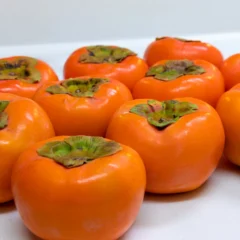
Hachiya (Patience Pays Off)
✅ Ripe when: Feels like a water balloon, skin translucent
✅ Squish test: Gentle press near stem = jiggly
🚫 Never eat firm! Astringency = mouth-numbing betrayal
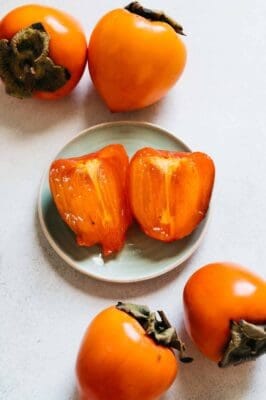
Pro Tip: Speed-ripen Hachiyas by storing with bananas in a paper bag! 🍌📦
Cultural Roots: Asia’s Autumn Treasure
Persimmons are beloved across Asia with deep traditions:
Japan 🇯🇵
- Hoshigaki: Whole persimmons painstakingly dried for weeks, developing a white sugar crust. A winter delicacy!
- Kaki-no-tane: Persimmon seeds are sometimes roasted as a snack (like pumpkin seeds).
Korea 🇰🇷
- Gotgamssi: Dried persimmons stuffed with walnuts – a festive New Year’s treat.
- Sujeonggwa: A traditional cinnamon-persimmon punch served with pine nuts.
China 🇨🇳
- Considered a symbol of good luck and often displayed during Lunar New Year.
- Shìzi Bing: Persimmon cakes made with dried fruit and flour.
Fun Fact: The word “persimmon” comes from the Native American putchamin! Spanish explorers brought them to Europe in the 1600s.
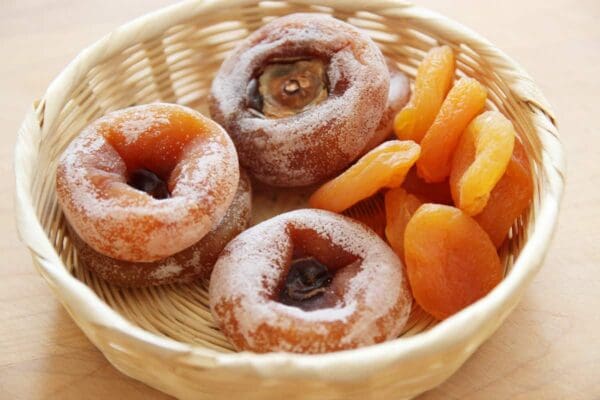
Black Spots & Spoilage: When to Worry
- Tiny black speckles = harmless (just sugar spots!).
- 🚫Large black patches or mushy spots = overripe or mold starting.
- 🚫Cracked skin + oozing = jungle trash (don’t risk it!).
“A gorilla’s rule: If it looks like it lost a fight, it probably tastes like it too.”

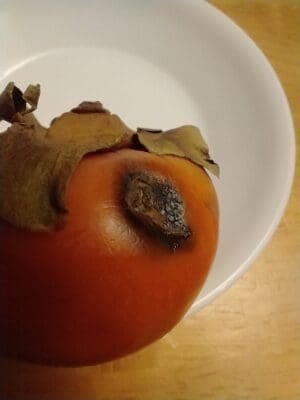
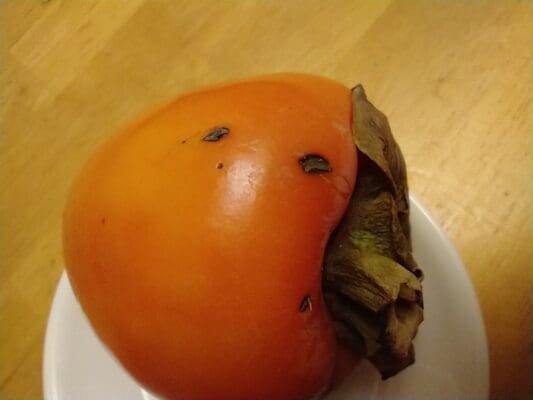
How to Cut & Eat Like a Pro
Fuyu (Crunchy Style):
- Wash skin (yes, it’s edible—like an apple!).
- Slice off leafy top, then cut into wedges or rounds.
- Remove seeds if present (some varieties have tiny ones).
If you don’t like the skin, you can use a knife to peel first.
Alternatively you can cut into quarters and then eat the flesh parts with your mouth. Or take a spoon and scoop out the flesh.
Hachiya (Gooey Mode):
- Wait until ultra-soft (no shortcuts!).
- Slice in half vertically, scoop out pulp with a spoon.
- Skin is edible but often bitter—gorillas usually skip it.
“Pro tip: Wear a bib. Hachiyas are the sloppiest fruit this side of the jungle.”
Storage Hacks
🌡️ Countertop: Fuyus last 1-2 weeks; Hachiyas ripen here.
❄️ Fridge: Ripe Hachiyas survive 2-3 days (eat fast!).
🧊 Freezer: Pulp freezes well for smoothies or baking.
Gorilla-Approved Ways to Eat
- Fuyu: Sliced with cheese, or eaten like an apple.
- Hachiya: Pureed into quick breads, muffins, or persimmon butter.
- Dried: Nature’s candy (find at Asian markets!).
Fun Fact: In Japan, persimmon leaves are used to wrap sushi (kakizushi)!
Final Thought
“Whether you’re Team Crunchy or Team Gooey, remember: persimmons are the autumn sun you can eat. And if you mess up? Just blame the gorilla.” 🦍🍊
